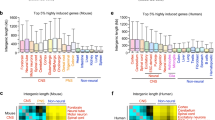Abstract
‘Identifier’ or ID sequences are present in 62% of the RNA polymerase II and III transcripts made in vitro from brain nuclei but in fewer than 4% of the transcripts made from the nuclei of other tissues. An homologous 160-nucleotide cytoplasmic poly(A)+ RNA species, BC1, and a smaller species, BC2, are located in vivo exclusively in neural tissues. Cloned ID sequences are polymerase III templates in vitro. Our data suggest a model in which brain-specific polymerase III transcription of ID sequences located in introns of brain genes activates those genes in a primary manner for polymerase II transcription.
Similar content being viewed by others
References
Sutcliffe, J. G., Milner, R. J., Bloom, F. E. & Lerner, R. A. Proc. natn. Acad. Sci. U.S.A. 79, 4942–4946 (1982).
Barta, A., Richards, R. I., Baxter, J. D. & Shine, J. Proc. natn. Acad. Sci. U.S.A. 78, 4867–4871 (1981).
Hojvat, S., Baker, G., Kirsteins, L. & Lawrence, A. M. Brain Res. 239, 543–557 (1982).
Milner, R. J., Bloom, F. E., Lai, C., Lerner, R. A. & Sutcliffe, J. G. Proc. natn. Acad. Sci. U.S.A. (in the press).
Thomas, P. Proc. natn. Acad. Sci. U.S.A. 77, 5201–5205 (1980).
Rigby, P. W. J., Dieckmann, M., Rhodes, C. & Bery, P. J. Molec. Biol. 113, 237–251 (1977).
Reddy, R. et al. J. biol. Chem. 256, 8452–8457 (1981).
Jelinek, W. & Leinwand, L. Cell 15, 205–214 (1978).
Milner, R. J. & Sutcliffe, J. G. Nucleic Acids Res. 11, 5497–5520 (1983).
Galli, G., Hofstetter, H. & Birnstiel, M. L. Nature 294, 626–631 (1981).
Weil, P. A., Luse, D. S., Segall, J. & Roeder, R. G. Cell 18, 469–484 (1979).
Brown, D. D. & Gurdon, J. B. Proc. natn. Acad. Sci. U.S.A. 79, 2064–2068 (1977).
Sutcliffe, J. G. Cold Spring Harb. Symp. quant. Biol. 43, 77–90 (1978).
Bogenhagen, D. F. & Brown, D. D. Cell 24, 261–270 (1981).
Manley, J. L., Fine, A., Cano, A., Sharp, P. A. & Gefter, M. L. Proc. natn. Acad. Sci. U.S.A. 77, 3855–3859 (1980).
Sudgen, B. & Keller, W. J. biol. Chem. 248, 3777–3788 (1973).
Spadafora, C., Ondet, P. & Chambon, P. Eur. J. Biochem. 100, 225–235 (1979).
Weisbrod, S. & Weintraub, H. Proc. natn. Acad. Sci. U.S.A. 76, 631–635 (1979).
Manley, J. L. & Colozzo, M. T. Nature 300, 376–379 (1982).
Sutcliffe, J. G., Milner, R. J., Shinnick, T. M. & Bloom, F. E. Cell 33, 671–682 (1983).
Levy, D. E., Lerner, R. A. & Wilson, M. C. Proc. natn. Acad. Sci. U.S.A. 79, 5823–5827 (1982).
Author information
Authors and Affiliations
Rights and permissions
About this article
Cite this article
Sutcliffe, J., Milner, R., Gottesfeld, J. et al. Identifier sequences are transcribed specifically in brain. Nature 308, 237–241 (1984). https://doi.org/10.1038/308237a0
Received:
Accepted:
Issue Date:
DOI: https://doi.org/10.1038/308237a0
- Springer Nature Limited
This article is cited by
-
Biosynthesis of brain cytoplasmic 200 RNA
Scientific Reports (2017)
-
A transcriptional analysis of the S1Bn (Brassica napus) family of SINE retroposons
Plant Molecular Biology (1996)
-
Genomic cloning and chromosomal assignment of rat regucalcin gene
Molecular and Cellular Biochemistry (1995)
-
Modular transposition and the dynamical structure of eukaryote regulatory evolution
Genetica (1992)
-
BC200 RNA in normal human neocortex, non-Alzheimer dementia (NAD), and senile dementia of the Alzheimer type (AD)
Neurochemical Research (1992)





